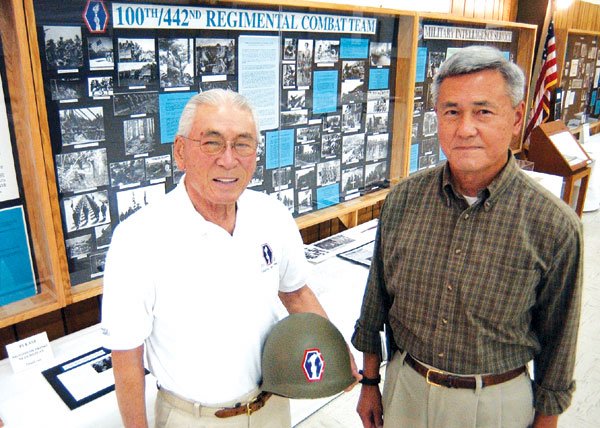The aircraft carrier that welcomed Apollo 11 astronauts home
from the Moon will next month become the site of a new
Japanese-American history exhibit now being created in the South
Valley.
The aircraft carrier that welcomed Apollo 11 astronauts home from the Moon will next month become the site of a new Japanese-American history exhibit now being created in the South Valley.
Earlier this year, Scott Armanini, the CEO of the U.S.S. Hornet floating museum docked in Alameda, saw an exhibit of Japanese-American history at Morgan Hill’s Buddhist Community Center. He requested a similar exhibit for the famous aircraft carrier, said Lawson Sakai, a Gilroy resident involved with the project.
The history exhibit will be placed in one of the carrier’s crew sleeping quarters, he said.
“Armanini proposed we get something up by the end of the year,” Sakai said. “It’s a significant exposure in the U.S.S. Hornet because of the number of people who go through.”
About 100,000 visitors pass through the Hornet annually at its Alameda base. This could become a potential million visitors a year if the ship is moved to a San Francisco dock as has been proposed, he said.
Exhibit creators plan to begin the display with a description of Japanese immigration to America at the end of the 19th century. This will depict the struggles and issues this first generation faced, Sakai said.
The exhibit will then explore the events leading up to the bombing of the U.S. Navy base at Pearl Harbor on Dec. 7, 1941. This surprise attack resulted in President Franklin Roosevelt signing an order “evacuating” about 120,000 people of Japanese ancestry from the West Coast. These people – most of them American citizens – were kept in various camps as prisoners of the U.S. government.
The main focus of the Hornet exhibit will be on the 15,000 Japanese-American men who fought in Europe as part of the segregated 100/442nd Regimental Combat Team as well as the 6,000 Japanese-American men who served in the Pacific front as part of the Military Intelligence Service.
Sakai, a second-generation – or Nisei – American, fought as an infantry soldier in the 442nd. He was part of the Easy Company unit in Italy that faced losses fighting German soldiers to rescue the “Lost Battalion.” This combat is considered one of the 10 most significant battles the U.S. Army has recorded.
The 442nd became the most decorated unit in U.S. military history. Its soldiers received more than 18,000 individual decorations including 9,500 Purple Hearts and 21 Medals of Honor. It also had the highest casualty rate of any American unit during World War II.
The Japanese Americans who participated in Military Intelligence also played an important role in the Pacific front, Sakai said. They translated enemy radio transmissions and documents. They also served as interpreters of captured Japanese soldiers.
Sakai said he hopes to get a temporary exhibit in the Hornet in early or mid-April.
“Right after we put that up, we’ll work on the permanent exhibit to be completed by San Francisco’s Fleet Week which starts in October,” he said. “It’s going to be a challenge. The thing is, it’s something worthwhile doing. This is part of our tell-the-story project.”
Brian Shiroyama, a Morgan Hill resident who was born during World War II in California’s Manzanar Internment Camp, worked closely with Sakai in building the Buddhist Community Center exhibit. He is now hard at work on the new Hornet exhibit, describing it as a labor of love to preserve and communicate the story of the Japanese who made their homes on the West Coast in the last century.
“The background is important,” he said. “They came looking for the dream. They worked hard. The first-generation folks thought that they’d finally reached their goal – built a home or bought a car for the first time. Then the evacuation order came, and they lost it all.”
The new exhibit will be kept in a large crew sleeping quarter on the Second Deck of the Hornet. Renovation work is now being done in preparation for the exhibit. Bunk beds will be converted into display frames, Sakai said.
The Hornet admirably served in World War II in the Pacific, he said. From the Hornet’s decks, Lt. Col. Jimmy Doolittle’s “Raiders” launched a squadron of B-25 bombers which did a bombing run over Tokyo in response to the Pearl Harbor attack.
The Hornet is also historic because it is the ship that picked up the Apollo 11 astronauts Neil Armstrong, Buzz Aldrin and Michael Collins after their space capsule plunged into the Pacific Ocean in July 1969.
Much of putting together the Hornet exhibit of Japanese-American history involves getting material donated and labor volunteered by South Valley residents, Shiroyama said.
“It’s hard to tell how much it’s going to cost,” he said. “A lot of cost is labor. I’ll provide the labor, but I still have to find the materials.”
Historical photos used for the exhibit must be mounted and displayed, he said. Cost of the projects is estimated at between $7,500 and $15,000, Sakai said.
The volunteers also hope to purchase a large TV set for continued video viewing in the exhibit room. They hope some local person or company might furnish this television. Docent volunteers are also needed to help man the exhibit.
The exhibit will serve to honor the memory of the Nisei men who fought in the 442nd as well as served in the U.S. Army’s Military Intelligence Service, Shiroyama said.
“Their motivation was extremely high because they had something to prove to this country: That they were in fact loyal citizens,” he said. “I think that’s why they performed so gallantly in both theaters.”
If you’re interested in helping in this project:
Write checks to Friends and Family of Nisei Veterans and mail to:
Lawson Sakai at P.O. Box 308, Gilroy, Calif. 95021.
Call (408) 842-3718 or e-mail ls****@****ic.com.
Japanese-American memorabilia, souvenirs, photos and other supplies for the exhibit can be sent to Brian Shiroyama.
Call (408) 776-0361 or e-mail bs********@***oo.com













